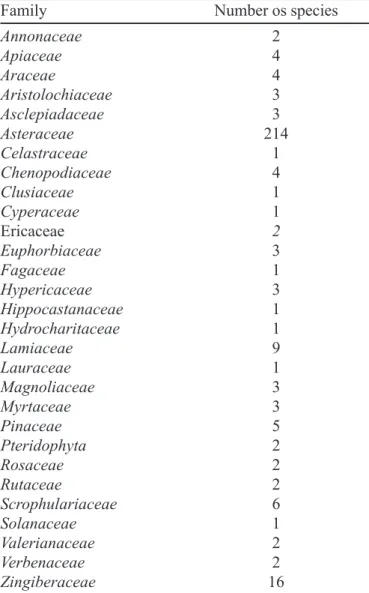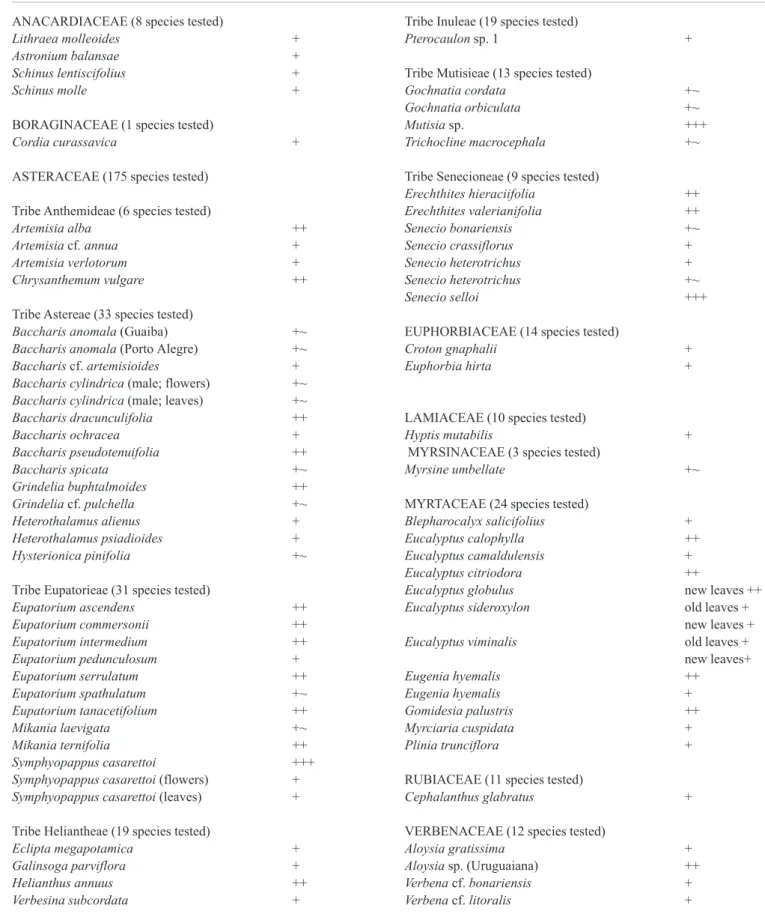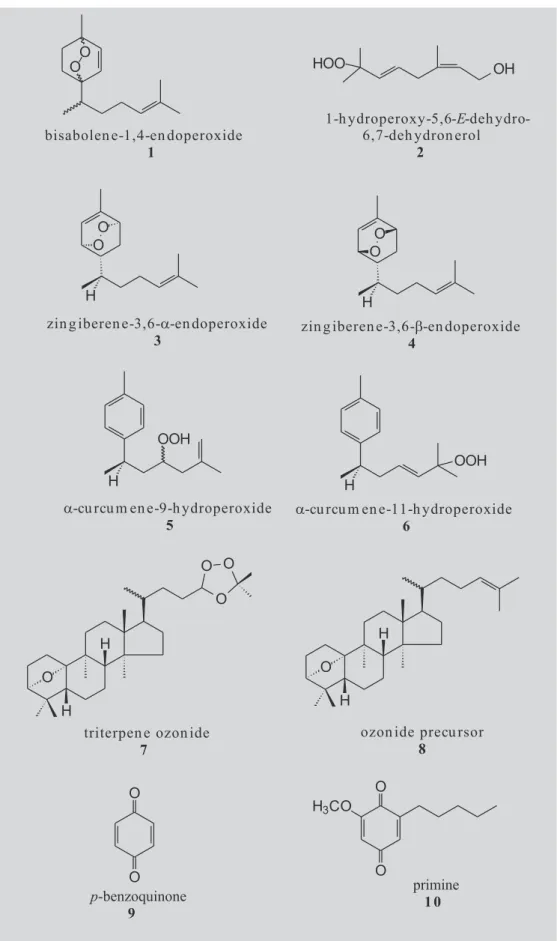vol. 38, n. 2, abr./jun., 2002
Screening of Brazilian plants for the presence of peroxides
Eloir Pedro Schenkel
1*, Gerhard Rücker
2, Detlef Manns
2, Miriam B. Falkenberg
3,
Nelson I. Matzenbacher
4, Marcos Sobral
1, Lilian A. Mentz
4, Sérgio A.L. Bordignon
5,
Berta M. Heinzmann
61Faculdade de Farmácia, Universidade Federal do Rio Grande do Sul, 2Pharmazeutisches Institut, Universität Bonn, 3Departamento de Ciências Farmacêuticas,Universidade Federal de Santa Catarina, 4Departamento de Botânica,
Universidade Federal do Rio Grande do Sul, 5Curso de Ciências Biológicas, Universidade Luterana do Brasil, 6Departamento de Farmácia Industrial, Universidade Federal de Santa Maria
Chloroform or dichloromethane extracts of 357 southern Brazilian plant species were tested for the presence of peroxides by thin-layer chromatography, using the spray reagent from Huber & Fröhlke. From the species tested, 71 (20%) showed positive results and most of them (56%) are Asteraceae species. The species tested were mainly from Asteraceae, but 55 more families were screened, in a total of 77 genera surveyed.
*Correspondence:
E.P. Schenkel
Departamento de Ciências Farmacêuticas
Centro de Ciências da Saúde Universidade Federal de Santa Catarina
Campus Universitário /Trindade 88.040-900 – Florianópolis-SC, Brasil E-mail: schenkel@ccs.ufsc.br
Uniterms: • Peroxides
• Antimalarial activity • Asteraceae
INTRODUCTION
The occurrence of natural products which contain a peroxide group has been known since 1911, when ascaridole was isolated from the essential oil of
Chenopodium ambrosioides (Chenopodiaceae). This oil was utilized as anthelmintic and ascaridole was identified as responsible for its activity (Gessner, 1953; Hope, 1958). In the following decades, compounds with a similar structure were not isolated; peroxides were considered to be too unstable and ascaridole was thought to be an exception.
In the meantime, as much as 320 peroxides have been isolated from natural material (Casteel, 1992). They occur mainly as terpene derivatives, although cumarine, fatty acids and alkaloids peroxides derivatives have also been isolated. Beside plants, many species of fungi and marine organisms produce metabolites containing a peroxide group. The peroxide function has been detected in different classes of natural compounds that are mentioned in Table I, based on the review published by Casteel (1992). The occurrence in vascular plant families according the literature published until 1999 is summarized by Table II.
Herewith we report the screening for detection of peroxides in extracts from higher plants from the states of Rio Grande do Sul and Santa Catarina, Brazil, based on Huber & Fröhlke’s chromatographic test. The screening was developed to select promising plants for detailed investigation, aiming the isolation and structure elucidation of new peroxides.
MATERIAL AND METHODS
Plants were collected from several localities in the aforementioned States, between December 1989 and February 1990, and identified by the authors N. Matzenbacher, M. Sobral, L. A. Mentz, and Sérgio A.L. or by the botanist Daniel Falkenberg (Universidade Federal de Santa Catarina). Voucher specimens were deposited at the ICN- Herbarium of the Instituto de Biociências da UFRGS, Porto Alegre, RS, Brazil.
Fresh plant material (10-20 g) was crushed and extracted with CH2Cl2 or CHCl3 (10-20 mL) previously tested for peroxides. The extraction procedures were performed at the same day of the plant collection; in the case of distant places, the macerates were prepared at the field and concentrated at the laboratory. After maceration for 4-10 h, the extracts were filtered and concentrated under reduced pressure until 1 mL, at temperatures below 40 °C. The concentrated extracts were then chromato-graphed on silicagel F254 TLC plates, with CH2Cl2. In the case that peroxide-like spots appeared at the front, the TLC analysis was repeated using petroleum ether: AcOEt (9:1) as eluting solvent. After elution, the TLC was observed under UV light at 254 and 366 nm. Afterwards
the peroxides were detected by a specific reagent described by Huber and Fröhlke (1972). With this reagent, hydroperoxides develop blue spots immediately, and for endoperoxides the blue color appears after a few minutes.
RESULTS AND DISCUSSION
A total of 500 samples of 357 species were collected, including male and female individuals (some
Baccharis species), and samples from different regions. The main target was Asteraceae, considering previous occurrence reports of peroxide compounds (Table II), and thus any found species was collected for the screening. Concomitantly, ca. the same number of species from other
TABLE I - Peroxide structures described in the literature considering the different classes of natural products
Class Number of compounds
Marine metabolites
Fatty acid derivatives 12
1,2-dioxancarboxilates 39
Others 11
Terrestrial sources
Small molecules, hemiterpenes, 22
and monoterpenes
Sesquiterpenes 149
Diterpenes 14
Triterpenes 5
Steroids 23
Others 9
TABLE II - Number of species of the different plant
families for which peroxides were reported (literature until 1999)
Family Number os species
Annonaceae 2
Apiaceae 4
Araceae 4
Aristolochiaceae 3
Asclepiadaceae 3
Asteraceae 214
Celastraceae 1
Chenopodiaceae 4
Clusiaceae 1
Cyperaceae 1
Ericaceae 2
Euphorbiaceae 3
Fagaceae 1
Hypericaceae 3
Hippocastanaceae 1
Hydrocharitaceae 1
Lamiaceae 9
Lauraceae 1
Magnoliaceae 3
Myrtaceae 3
Pinaceae 5
Pteridophyta 2
Rosaceae 2
Rutaceae 2
Scrophulariaceae 6
Solanaceae 1
Valerianaceae 2
Verbenaceae 2
plant families were included to test the hypothesis of a restrictive distribution of peroxides. These samples of other families were collected randomly, and in the case of a positive result, more species from the same family were tested. Apart from the Asteraceae species, we tested 182 plants from 55 families, ca.1-3 species for each family, but in some cases a larger number were tested, as in the case of Myrtaceae (24 species), Euphorbiaceae (14), Verbenaceae (12) and Lamiaceae (11). Table III presents the 71 species tested which gave positive results and the plant material used for the extraction. Among the 175 species of Asteraceae tested for the presence of peroxides in leaves and blossoms, 40 (30%) showed positive results. In the 182 plants classified in other families, 26 (14%) showed positive results. These results indicated a higher occurrence of peroxides in the Asteraceaefamily and confirmed the literature data (Table II), but suggested that they can also be found frequently in other plant families, such as Myrtaceae and Verbenaceae.
Within the Asteraceae a higher rate of positive results were observed in genera belonging to the tribes Anthemideae and Senecioneae. Otherwise, in some tribes there were no samples with positive reaction, as in the case of Vernonieae (13 species tested), Cichorieae (3), Cynareae (2) , Helenieae (2) (results not shown), or with a low rate, as in the case of tribes Inuleae (19 species tested, 1 positive result). The species which gave negative reaction with the peroxide reagent are not presented. The list of these plants can be obtained from the author to whom correspondence should be addressed.
From the plants listed on Table III, several were selected for detailed investigation, observing also factors as the abundance of the species and the foliar mass. From these works (Falkenberg, 1991; Marek, 1994; Heinzmann, 1996; Rücker et al., 1996) some new peroxides were isolated. Some of the isolated peroxides were also tested for antimalarial activity, semi-synthesized and derivatized (Rücker, 1994). The compound with most promising activity was 1 (bisabolene-1,4-endoperoxide=1,4-epidioxy-bisabolan-2,12-diene) (Figure 1), for which in vitro an IC50 0.05 was observed, in comparison with the value 0.005 for artemisinine as reference compound (Heinzmann, 1996; Rücker et al., 1997). Since the
compound 1 was isolated from Heterothalamus
psiadioides, H. alienus, Senecio selloi and Eupatorium rufescens (Heinzmann, 1996; Rücker et al., 1996; Rücker
et al., 1996) it seems to have a wide occurrence, being first reported from Rudbeckia lasciniata (Bohlmann et al., 1978), and also from Ligularia speciosa (Bohlmann, Fritz, 1980), Chamaemelum fuscatum (Pascual et al. 1983) and
Senecio desfontnei (Metwally, Dawidar, 1986). Two
others bisabolan-type sesquiterpenes, zingiberene-3,6-a-and zingiberene-3,6-b-endoperoxides (3 and 4) were isolated from S. selloi and E. rufescens and also showed antimalarial activity in vitro, but this activity was weaker than the activity of bisabolene-1,4-endoperoxide. S. selloi
also contains two hydroperoxides (5 and 6) , which were identified indirectly by isolation, identification and poste-rior photooxidation of α-curcumene, their precursor in the plant (Figure 1). The detailed investigation of the CH2Cl2 extract of S. selloi also showed a greyish blue spot with the Huber’s peroxide reagent. After isolation, this compound was identified as a triterpene ozonide (7), which contains a new 9-epi-cucurbitan skeleton (8) (Rücker et al., 1999). The possible occurrence of peroxides in species of Myrtaceae, as suggested by our screening, was a subject of a detailed investigation. The substances giving positive reaction in the extracts from Eugenia hyemalis and
Paramyrciaria glazioviana were isolated; the structure elucidation revealed these compounds to be the quinones 9, 10 (Figure 1) (Falkenberg, 1996). The high oxidation potential of this class is pointed as the reason for the positive reactions with the Huber’s peroxide reagent (Kiefer, 1994).
ACKNOWLEDGMENTS
This work was supported by the German Institution Stifterverband für die Deutsche Wissenschaft (SV), the Brazilian agencies Fundação de Amparo a Pesquisa do Estado do Rio Grande do Sul (FAPERGS) and Conselho Nacional de Desenvolvimento Científico e Tecnológico (CNPq).
RESUMO
Investigação de plantas brasileiras quanto à presen-ça de peróxidos
Extratos clorofórmicos ou diclorometânicos de 357 es-pécies vegetais de ocorrência no sul do Brasil foram tes-tados quanto à presença de peróxidos, através de cromatografia em camada delgada, utilizando o reagente de detecção de Huber & Fröhlke. Das espécies testadas, 71 (20%) apresentaram resultado positivo, a maioria de-las (56%) pertencentes à família Asteraceae. A maioria das espécies testadas pertencia a Asteraceae, mas outras 55 famílias foram também testadas, abrangendo um total de 77 gêneros.
Tribe Inuleae (19 species tested)
Pterocaulon sp. 1 +
Tribe Mutisieae (13 species tested)
Gochnatia cordata +~
Gochnatia orbiculata +~
Mutisia sp. +++
Trichocline macrocephala +~
Tribe Senecioneae (9 species tested)
Erechthites hieraciifolia ++
Erechthites valerianifolia ++
Senecio bonariensis +~
Senecio crassiflorus +
Senecio heterotrichus +
Senecio heterotrichus +~
Senecio selloi +++
EUPHORBIACEAE (14 species tested)
Croton gnaphalii +
Euphorbia hirta +
LAMIACEAE (10 species tested)
Hyptis mutabilis +
MYRSINACEAE (3 species tested)
Myrsine umbellate +~
MYRTACEAE (24 species tested)
Blepharocalyx salicifolius +
Eucalyptus calophylla ++
Eucalyptus camaldulensis +
Eucalyptus citriodora ++
Eucalyptus globulus new leaves ++
Eucalyptus sideroxylon old leaves + new leaves +
Eucalyptus viminalis old leaves + new leaves+
Eugenia hyemalis ++
Eugenia hyemalis +
Gomidesia palustris ++
Myrciaria cuspidata +
Plinia trunciflora +
RUBIACEAE (11 species tested)
Cephalanthus glabratus +
VERBENACEAE (12 species tested)
Aloysia gratissima +
Aloysia sp. (Uruguaiana) ++
Verbena cf. bonariensis +
Verbena cf. litoralis + ANACARDIACEAE (8 species tested)
Lithraea molleoides +
Astronium balansae +
Schinus lentiscifolius +
Schinus molle +
BORAGINACEAE (1 species tested)
Cordia curassavica +
ASTERACEAE (175 species tested)
Tribe Anthemideae (6 species tested)
Artemisia alba ++
Artemisia cf. annua +
Artemisia verlotorum +
Chrysanthemum vulgare ++
Tribe Astereae (33 species tested)
Baccharis anomala (Guaiba) +~
Baccharis anomala (Porto Alegre) +~
Baccharis cf. artemisioides +
Baccharis cylindrica (male; flowers) +~
Baccharis cylindrica (male; leaves) +~
Baccharis dracunculifolia ++
Baccharis ochracea +
Baccharis pseudotenuifolia ++
Baccharis spicata +~
Grindelia buphtalmoides ++
Grindelia cf. pulchella +~
Heterothalamus alienus +
Heterothalamus psiadioides +
Hysterionica pinifolia +~
Tribe Eupatorieae (31 species tested)
Eupatorium ascendens ++
Eupatorium commersonii ++
Eupatorium intermedium ++
Eupatorium pedunculosum +
Eupatorium serrulatum ++
Eupatorium spathulatum +~
Eupatorium tanacetifolium ++
Mikania laevigata +~
Mikania ternifolia ++
Symphyopappus casarettoi +++
Symphyopappus casarettoi (flowers) +
Symphyopappus casarettoi (leaves) +
Tribe Heliantheae (19 species tested)
Eclipta megapotamica +
Galinsoga parviflora +
Helianthus annuus ++
Verbesina subcordata +
FIGURE 1 - Compounds isolated from Heterothalamus alienus (1, 2, 3 and 4), H. psiadioides (1), Eupatorium rufescens
REFERENCES
BOHLMAN, F., FRITZ, U. Isofukinone, an eremophilane from Ligularia speciosa. Phytochemistry, v.19, p. 2471-2472, 1980.
BOHLMAN, F., JAKUPOVIC, J., ZDERO, C. Neue Norsesquiterpene aus Rudbeckia lasciniata und Senecio paludoaffinis. Phytochemistry, v.17, p. 2034-2436, 1978.
CASTEEL, D. A. Peroxy natural products. Natural Product Reports, v. 24, p. 289-312, 1992.
FALKENBERG, M. B. Chinone und andere Inhaltsstoffe aus
Eugenia hiemalys Camb. und Paramyrciaria glazioviana
(Kiaerskou) Sobral. Boon, 1996. 84p. [PhD Thesis. Universität Bonn].
GESSNER, O. Die Gift- und Arzneipflanzen von Mitteleuropa. Heidelberg: Carl Winter-Universitätsverlag, 1953. 933 p.
HEINZMANN, B. M. Inhaltsstoffe aus Senecio selloi
Spreng. de Candolle. Boon, 1996. 149p. [PhD Thesis. Universität Bonn].
HOPE, H. A. Drogenkunde. 7 ed. Hamburg: Cram, de Gruyter & Co, 1958. 1231 p.
HUBER, H., FRÖHLKE, E. A new spray-reagent for the detection and quantitative estimation of peroxides.
Chromatographia, v. 5, p. 256-257, 1972
KIEFER, A. Untersuchungen zur quantitativen bestimmung von peroxiden am beispiel der schafgarbe. Boon, 1994. 136p. [PhD Thesis. Universität Bonn].
KIRBY, G. C. Medicinal plants and the control of protozoan disease, with particular reference to malaria. Trans. R. Soc. Trop. Med.Hyg.,v.90, p. 605-609, 1996.
KLAYMAN, D.L. Qinghaosu (Artemisinin) – An antimalarial drug from China. Science, v. 228, p.1049-1055, 1985.
MAREK, A. M. E. Peroxide und andere Inhaltsstoffe aus
Heterothalamus-Arten und malariawirksame
Abwandlungsprodukte der Peroxide. Boon, 1994. 202p. [PhD Thesis. Universität Bonn].
METWALLY, M. A., DAWIDAR, A. A. Constituents of
Senecio desfontanei. Pharmazie, v. 41, p. 552-553, 1986.
PASCUAL, J., DE CABALLERO, E., ANAYA, J., GONZALEZ, M. S. Four aliphatic esters of
Chamamelium fuscatum essential oil. Phytochemistry, v. 22, p. 1757-1759, 1983.
RÜCKER, G.Pharmazeutisch wichtige Naturstoffe im Blickpunkt. Pharmazie in unserer Zeit,v. 23, p. 223-225, 1994.
RÜCKER, G., BREITMAIER, E., MANNS, D., MAIER, W., MAREK, A.,HEINZMANN, B., HEIDEN, K., SEGGEWIES, S. Antimalarial activity of 1,4-epidioxy-bisabola-2,12-diene derivatives. Arch. Pharm. Med. Chem., v. 330, p.12-16, 1997.
RÜCKER, G., SCHENKEL, E. P., MANNS, D., FALKENBERG, M., MAREK, A., Peroxides and other
constituents from Heterothalamus alienus.
Phytochemistry, v. 41, p. 297-300, 1995.
RÜCKER, G., SCHENKEL, E.P., MANNS, D., MAYER, R., HAUSEN, B.M., HEIDEN, K. Allergenic Sesquiterpene lactones from Eupatorium cannabinum L. and Kaunia rufescens. Nat. Toxins, v. 5, p. 223-227, 1997.
RÜCKER, G., SCHENKEL, E.P., MANNS, D., MAYER, R., HEIDEN, K., HEINZMANN, B.M. Sesquiterpene Peroxides from Senecio selloi and Eupatorium rufescens.
Planta Med., v. 62, p. 565-566, 1996.
RÜCKER, G., MANNS, D., SCHENKEL, E. P., HARTMANN, R., HEINZMANN, B. M. Sesquiterpene peroxides from Senecio selloi.Phytochemistry, v. 52, p. 1587-1591, 1999.
VENNERSTROM, J. L.; EASTON, J. W. Oxidants, oxidant drugs and malaria. J. Med. Chem., v.31, p. 1269-1277, 1988.


